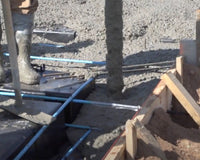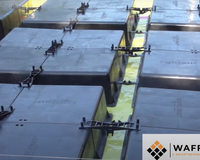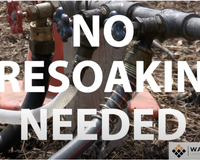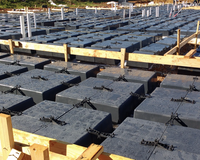John Cook | S.E. | Principal, MKM & Associates Structural Engineering
Executive Summary
This paper provides a discussion and summary of the performance of Wafflemat slabs on grade. The discussion contained herein is based upon studies performed by the geotechnical firm of Purcell, Rhoades & Associates (ref. 1), as well as observations of the performance of installed Wafflemat foundations (Appendices A-D) over a twenty-year period.
Post-tensioned, slab-on-grade construction and mild reinforced mats have been used for decades to provide adequate support for residential and light commercial construction. The original, post-tensioned slabs were constructed by trenching to form in-ground beams (or “ribs”) to provide stiffness when combined with a relatively thin slab. Subsequently, uniform thickness post-tensioned slabs (or, “UTF’s” for “Uniform Thickness Foundation”) were utilized with or without perimeter in-ground beams. The uniform thickness slabs are much thicker than slabs of the in-ground beam system, and have gained some prominence in certain parts of the world.


Figure 1 - Wafflemat foundation forms, ready for concrete pouring. Post-tensioning cables are positioned in the spaces between the Waffleboxes.
Post-tensioned slabs provide a mat foundation which tolerates movement to an acceptable limit. The deflection limits must be compatible with the type of construction supported by the post-tensioned slab. Deflection arises from differential swelling or shrinking of the soil underneath the slab, expressed in terms of edge lift or center lift. This deflection is mitigated by the slab stiffness and strength.
The soil contact area of the slab in both the in-ground ribbed slabs and the uniform thickness slabs is equal to the total slab area. This means that when the slab is subjected to uplift forces from soil expansion, 100% of the soil expansion area below the slab exerts force on the slab. The upward force is resisted by the slab stiffness, weight of the slab, and structure above.
More recently, a third-generation post-tensioned slab has been used in the United States and Mexico. It utilizes hollow forms, or “Waffleboxes,” in a grid arrangement, the forms being placed directly on grade to create voids in a waffle-like pattern, with ribs in both directions and post-tensioning tendons located in the ribs. Concrete is then placed over the forms, creating the “Wafflemat” foundation.


Figure 2 - Cutaway view of the Wafflemat foundation. Only the perimeter and interior ribs are in contact with the soil, increasing the bearing stress while allowing swelling soils to expand into the void spaces between ribs.
The Wafflemat is in contact with the ground only at the bottom of the ribs created by the Waffleboxes, a contact area much less than the total slab area. Reduction of the contact area is significant in that there is less surface upon which swelling soils can exert force and the superimposed bearing stress is increased. The resulting higher bearing stress from the structure counteracts soil swelling pressures. In contrast, in- ground ribbed slabs and uniform thickness slabs have lower bearing stress, and thus have a lower capacity to resist swelling pressures.
A study completed in 1997 (ref. 1) monitored 28 Wafflemat foundations under adverse conditions. The study showed that little movement was measured over a 12-month period for the Wafflemats, which were conventionally reinforced. The pad preparations varied greatly: some were heavily pre-soaked, others not at all. Level readings from the study showed excellent mitigation of expansive soil effects for the 28 Wafflemat foundations on soil with PI’s ranging from 26 to 58.
Earlier research, noted in the 1997 study, showed that pressures caused by swelling soils were reduced by the voids in Wafflemat foundations. The soil pressures were relieved by the soil expanding up to several vertical inches into the voids. Level readings taken on top of the Wafflemats showed little movement in spite of the Wafflemat having been built on moderately dry subgrade, and subsequently partially flooded on one side to simulate extreme conditions. Over time, the moisture under the Wafflemat stabilized and became uniform. Throughout this process the level readings varied little, and the performance of the Wafflemat foundations fell well within serviceability limits.
Current practice in the design of post-tensioned Wafflemat foundations utilizes the 3rd Edition of the Post Tensioning Institute’s “Design of Post-Tensioned Slabs-on-Ground.” This means a Wafflemat foundation is designed to obtain the same stiffness as ribbed mats or uniform thickness slabs.
However, the inherent performance of the Wafflemat is superior. With the same stiffness, yet reduced contact area, the Wafflemat experiences less movement. In essence this foundation system, with equivalent stiffness, experiences significantly less upward loading.
In summary, millions of square feet of residential Wafflemat have been tested by observing behavior under severe conditions for over 15 years. During this time, foundation movement due to swelling soils has proven to be well within acceptable limits. Current design practice provides post-tensioned Wafflemat slabs with stiffness equal to or better than other post-tensioned slab types, but with less susceptibility to swell pressures exerted by expansive soils. The Wafflemat provides all of the benefits of the in-ground rib and uniform thickness slabs, but with better performance provided by its geometry and smaller contact area. This approach provides a superior performing slab as evidenced by field testing and lack of structural distress at installations to date.





